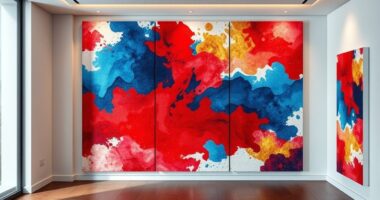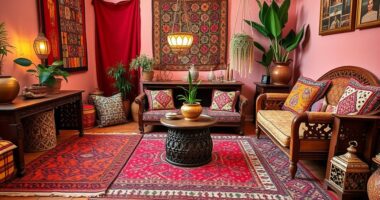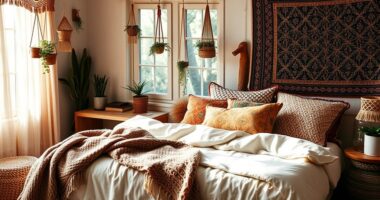To create a nature-inspired boho interior, incorporate lush indoor plants like pothos or monstera in woven baskets or terracotta pots to bring life and calm. Use reclaimed wood furniture and natural accents such as carved bowls or live-edge pieces for warmth and texture. Add tactile interest with organic fibers like jute or seagrass in rugs and baskets. Supporting sustainable sources guarantees your space stays authentic and eco-friendly. Keep exploring to discover how these elements come together seamlessly.
Key Takeaways
- Incorporate lush indoor plants in woven baskets or macramé hangers to create a vibrant, tranquil atmosphere.
- Use reclaimed and artisan wood pieces for furniture and accents to add warmth and rustic charm.
- Layer natural fibers like jute, hemp, and seagrass in rugs, baskets, and textiles for texture and eco-friendly appeal.
- Choose sustainable, certified natural materials such as bamboo, water hyacinth, and organic textiles for eco-conscious decor.
- Maintain greenery and wooden elements regularly with natural cleaning methods to preserve their beauty and sustainability.
Embracing Natural Elements in Boho Design

To achieve a truly boho-inspired space, you should embrace natural elements that reflect a free-spirited, earthy vibe. Incorporate natural materials like reclaimed wood, bamboo, and wicker into your furniture and decor to add warmth and organic textures. Layer woven fibers such as jute, hemp, and seagrass through rugs, baskets, and wall hangings to reinforce the earthy aesthetic of boho design. Use indoor plants like fiddle leaf figs, pothos, and air plants to bring life and a lush feel to your space. Stick to earthy tones, which enhance the natural, grounded ambiance. Prioritize sustainable decor choices and natural materials to support eco-friendly style. Additionally, incorporating lighting options such as candles and string lights can create a cozy, inviting atmosphere that enhances the natural elements. Incorporating self watering plant pots can also help maintain healthy and vibrant indoor plants with minimal effort, supporting sustainable decor and complementing the natural theme. By seamlessly blending these elements, you create a harmonious, nature-inspired boho interior that feels both relaxed and authentic.
The Role of Indoor Plants in Creating a Lush Atmosphere
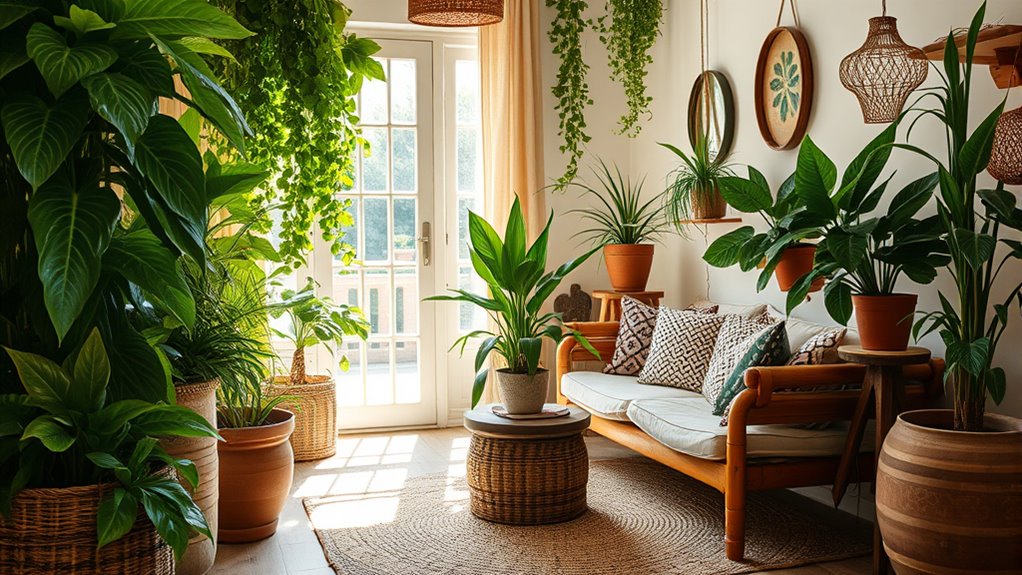
Indoor plants are the perfect way to bring the natural elements of boho decor to life. By adding lush greenery like pothos, fiddle-leaf figs, and monstera, you enhance the layered textures that define boho interiors. Proper plant placement near natural light maximizes their health and visual appeal, creating a vibrant, lively atmosphere. Incorporate plants in woven baskets, terracotta pots, or macramé hangers to add organic warmth and texture, enriching the eclectic aesthetic. The greenery not only adds visual interest but also fosters a calming environment, reducing stress and boosting mood. Strategically placed indoor plants transform your space into a lush, nature-inspired sanctuary, seamlessly blending form and function while reinforcing the authentic, relaxed vibe of boho style.
Incorporating Wooden Accents for Warmth and Texture
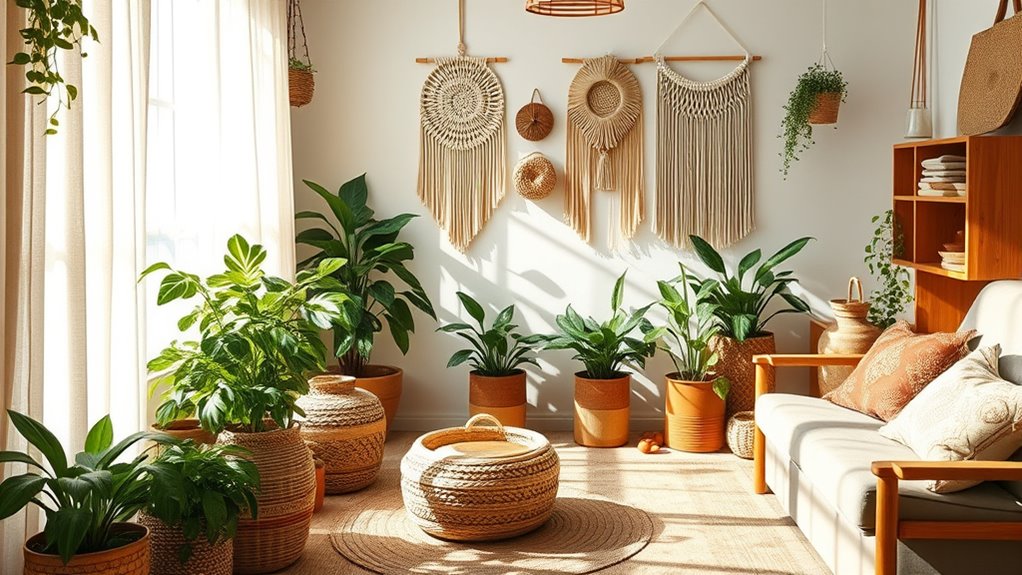
Incorporating wooden accents into your boho interiors instantly adds warmth and rich texture that evoke a natural, inviting atmosphere. Reclaimed wood furniture, natural wall panels, and carved bowls bring organic textures and artisanal craftsmanship to your space. Using a variety of wood finishes, from light oak to dark mahogany, creates layered depth and visual interest. Live-edge wood pieces introduce a rustic style, emphasizing the connection to nature. Handcrafted details enhance the handmade decor aesthetic, making each piece unique. Combining wooden accents with other organic materials like rattan or woven fibers amplifies the earthy, textured feel characteristic of boho decor. These wooden elements enrich your space with warmth and tactile richness, grounding your interiors in natural beauty. Additionally, integrating natural materials through sound design techniques—such as ambient sounds of nature or subtle forest soundscapes—can further enhance the calming, earthy vibe of your space. Incorporating plant arrangements and natural fibers in textiles and decor items can also deepen the organic, earthy atmosphere. Going further, driftwood accents can introduce unique, weathered textures that complement your wooden decor. Incorporating wooden accents thoughtfully ensures a cohesive and harmonious natural aesthetic throughout your home.
Using Natural Fibers to Add Tactile Interest

Natural fibers like jute, hemp, and seagrass bring rich texture and earthy tones to boho interiors, creating a tactile experience that invites touch and exploration. You can incorporate these materials through textured rugs, baskets, and woven textiles that develop a unique patina over time, enhancing the authentic, aged look of your decor. Handcrafted accents such as seagrass baskets or jute poufs emphasize artisanal craftsmanship, adding depth and personality. These organic materials introduce rough textures and earthy tones that beautifully complement other natural elements like wood and stone. Using natural fibers not only enhances visual and tactile interest but also supports sustainable decor choices, aligning with environmentally conscious sustainability principles. Incorporating eco-friendly materials like rattan furniture and woven textiles from natural fibers further elevate your space, blending beauty with eco-consciousness in your boho sanctuary. Introducing natural textures such as burlap or sisal can also enrich the sensory experience, making your interior feel more inviting and grounded. Incorporating emotional support strategies can help create a calming environment that nurtures well-being and comfort within your space.
Selecting Eco-Friendly Materials for Sustainability

Choosing eco-friendly materials for your boho interior not only enhances sustainability but also adds authenticity and character to your space. Focus on sustainable materials like reclaimed wood, organic fibers, and eco-conscious textiles to minimize environmental impact. Reclaimed wood offers a natural finish that highlights its history while reducing waste. Fast-growing renewable resources such as bamboo, jute, and hemp provide durable, biodegradable options that support a greener lifestyle. Look for certifications like FSC, GOTS, or OEKO-TEX to ensure ethical sourcing. Incorporate natural finishes and dyes to promote healthier indoor air quality. Supporting artisanal craftsmanship and choosing biodegradable options helps preserve traditional techniques and reduces reliance on synthetic fibers and plastics, making your decor both beautiful and environmentally responsible.
Mixing Vintage and Handcrafted Pieces for Eclectic Charm

Blending vintage and handcrafted pieces in your boho interior creates a vibrant, layered look that reflects authenticity and personal style. Vintage furniture, like reclaimed wooden tables or antique armoires, introduces history and character, grounding the space in timeless charm. Handcrafted decor—woven baskets, macramé hangings, and artisanal pottery—adds texture and showcases craftsmanship, emphasizing the imperfect beauty of handmade items. Together, these elements form a curated, eclectic mix that highlights your unique taste and cultural influences. This combination celebrates artisanal skills and supports sustainable craftsmanship, making your space feel genuine and inviting. Incorporating vintage and handcrafted pieces results in a textured, personalized environment that embodies the free-spirited essence of boho design. Additionally, selecting sustainable materials that serve both aesthetic and functional purposes can enhance the overall harmony of your space. Using eco-friendly textiles in your decor can further promote environmental consciousness and add softness to your interiors. To ensure safety and longevity, maintaining proper installation and maintenance of your decor and furniture is essential. Embracing these sustainable and artisanal elements can also contribute to a more eco-conscious lifestyle, aligning your interior design with broader environmental values.
Color Palettes Inspired by Nature
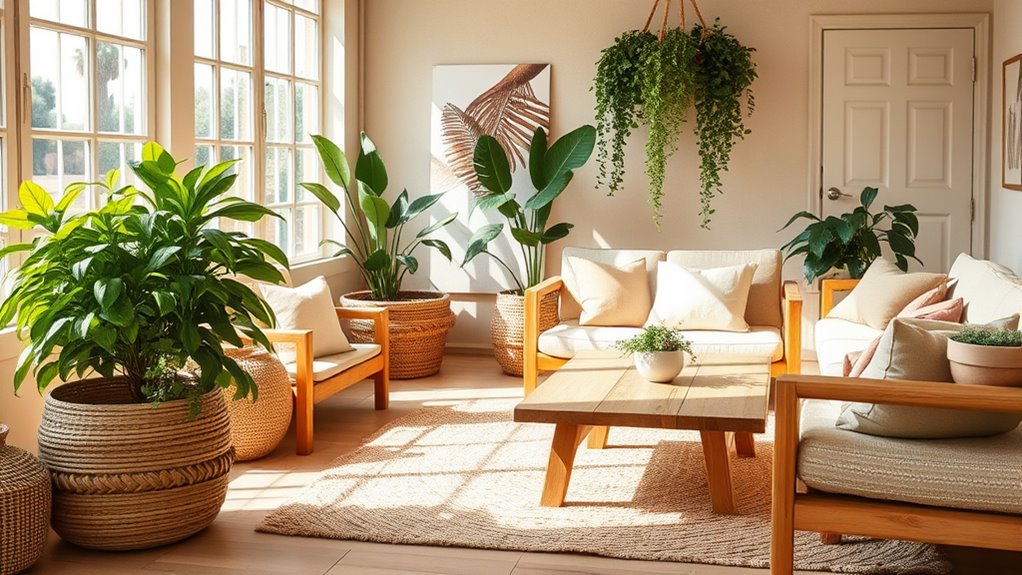
Incorporating color palettes inspired by nature enhances the authentic, layered feel of your boho interior. Focus on earthy tones like warm browns, sandy beiges, and soft terracotta to create a calming foundation. Muted greens and botanical colors, such as leafy greens and floral pinks, add vibrancy while maintaining harmony with natural shades. Landscape-inspired palettes evoke a sense of serenity, reflecting elements like lush forests or coastal sands. Opt for matte textures and organic finishes to keep the look understated and authentic. These natural hues and finishes foster a relaxed, earthy atmosphere, perfectly suited for a boho space. Understanding color psychology in design can help you choose hues that promote tranquility and well-being. Incorporating decluttering strategies can further highlight these natural elements by creating a clean, harmonious environment that celebrates nature’s beauty and tranquility. Additionally, selecting natural fiber textiles enhances the tactile warmth and authenticity of the space. Embracing the principles of creative practice allows you to experiment with color combinations and textures, making your interior truly unique and reflective of your personal connection to nature.
Tips for Maintaining and Caring for Your Greenery and Natural Decor
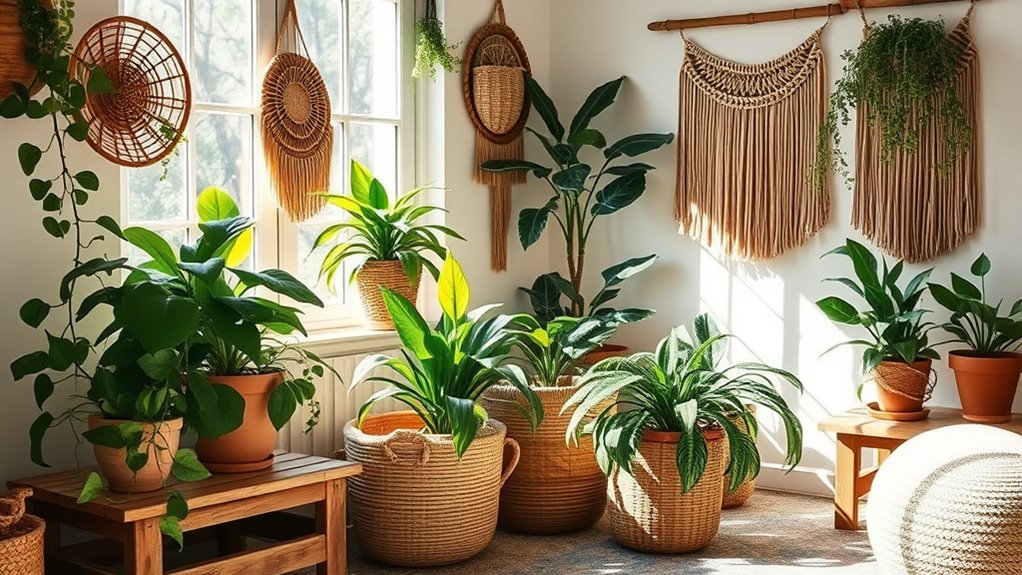
To keep your greenery and natural decor looking their best, you’ll want to develop a simple maintenance routine. Regularly water each plant according to its needs, and use natural fertilizers to encourage healthy growth. Don’t forget to clean leaves and rotate your plants to guarantee even light exposure and vibrant, long-lasting beauty. Incorporating proper watering techniques can also help you ensure your plants stay healthy and resilient.
Watering and Feeding Tips
Maintaining your greenery and natural decor in a boho-inspired space requires attentive watering and feeding routines. For indoor plants, water when the top inch of soil feels dry, usually once a week, to prevent overwatering and root rot. Use room-temperature, filtered water to promote healthy growth and avoid shocking the roots. During the growing season, feed your plants with a balanced, water-soluble fertilizer every 4-6 weeks to ensure proper nutrients. Adjust watering frequency based on plant type, season, and indoor humidity—watering more in warmer months and less in winter. Regularly check for pests and remove dead leaves to support plant care. Incorporating essential oils in your space can enhance your environment with natural aromas that promote relaxation and well-being. Proper plant nutrition is essential for maintaining vibrant greenery that complements your natural fibers and boho aesthetic. Consistent watering and feeding are key to maintaining vibrant greenery that complements your natural fibers and boho aesthetic, especially considering that special occasions often inspire home refreshes and celebrations of natural beauty. Additionally, using an air purifier can help maintain optimal indoor air quality, ensuring a healthier environment for both your plants and your living space.
Cleaning and Maintenance Routines
Keeping your greenery and natural decor looking their best requires regular cleaning and careful maintenance. Dusting plant leaves with a damp cloth prevents dust buildup, boosting photosynthesis. Proper watering according to each plant’s needs avoids overwatering and root rot. Use natural, non-toxic cleaning products on wood and fiber decor to protect their finish. Keep natural fibers like jute and hemp clean by vacuuming or spot-cleaning with mild detergent. Rotation of plants ensures even light exposure and healthy growth, while pest inspection helps catch issues early. Regular maintenance keeps your boho interiors vibrant and healthy.
| Task | Frequency | Tips |
|---|---|---|
| Dusting & cleaning | Weekly | Use damp cloth or mild detergent |
| Watering | Once a week | Adjust for plant needs |
| Pest inspection | Bi-weekly | Look for pests or disease |
| Rotation | Monthly | Prevent uneven growth |
Sourcing High-Quality Natural Materials for Your Boho Space

Sourcing high-quality natural materials for your boho space involves more than just shopping; it requires intentional choices that prioritize sustainability and craftsmanship. Focus on natural materials like rattan, wicker, and water hyacinth, which you can find through artisans or suppliers committed to sustainable sourcing and fair trade practices. Reclaimed wood and vintage pieces are excellent eco-friendly options, often available via specialty antique stores or online marketplaces such as Etsy or 1stDibs. Organic fibers like jute, hemp, and seagrass should come from certified suppliers that adhere to sustainable manufacturing standards. For plants and planters, select biodegradable planters or handcrafted ceramic containers from nurseries specializing in native species. Always verify authenticity by checking certifications, artisan stories, or reviews to guarantee durability, ethical sourcing, and aesthetic quality.
Frequently Asked Questions
How Do I Balance Natural Elements With Modern Decor?
Balancing natural elements with modern decor starts with choosing a neutral color palette to create harmony. You can incorporate plants, wood, and natural fibers as accent pieces without overwhelming the space. Mix sleek, modern furniture with textured natural elements to add warmth and interest. Keep clean lines and minimal clutter to maintain a contemporary feel, while allowing the natural materials to serve as focal points that soften and enrich your decor.
What Are Eco-Friendly Options for Sourcing Natural Materials?
When sourcing natural materials, you want to prioritize eco-friendly options that support sustainability. Look for suppliers who use renewable resources, certified organic products, and locally sourced materials to reduce your carbon footprint. Choose reclaimed, recycled, or upcycled items whenever possible, and support brands committed to ethical practices. By making conscious choices, you help protect the environment while creating a beautiful, authentic boho space that celebrates nature.
How Can I Incorporate Sustainable Practices Into My Boho Design?
To incorporate sustainable practices into your boho design, start by choosing eco-friendly materials like reclaimed wood, organic textiles, and biodegradable fibers. Opt for local and fair-trade sources to reduce your carbon footprint. Incorporate energy-efficient lighting and upcycle existing decor to minimize waste. You can also support brands committed to sustainability. By making thoughtful choices, you create a stylish, eco-conscious space that reflects your values and love for nature.
Which Plants Are Best for Low-Light Indoor Environments?
You’re wondering which plants thrive in low-light indoor spaces. Start with snake plants, known for their resilience and low light adaptability. Pothos and ZZ plants also do well in shaded areas, requiring minimal care. These plants not only brighten your space but also improve air quality. By choosing these hardy options, you create a lush, inviting environment that’s easy to maintain even with limited sunlight.
How Do I Protect Natural Fibers From Pests and Damage?
Pests and damage threaten your beautiful natural fibers, but you can protect them easily. Keep your space clean and dry, since pests thrive in damp environments. Regularly inspect your textiles and treat any signs of infestation promptly. Use natural repellents like neem oil or cedar blocks to deter insects without harsh chemicals. By maintaining a healthy environment, you preserve the charm of your boho interior while safeguarding your natural fibers.
Conclusion
By blending lush greenery with warm wood and soft natural fibers, you create a vibrant, inviting boho space. It’s a gentle chaos of textures and hues, where sustainability meets style. Embrace the wild beauty of nature inside your home, but remember, caring for your plants and materials is your daily act of love. In this harmony of natural elements, you find not just decor, but a sanctuary that breathes with life and authenticity.




